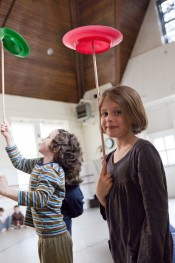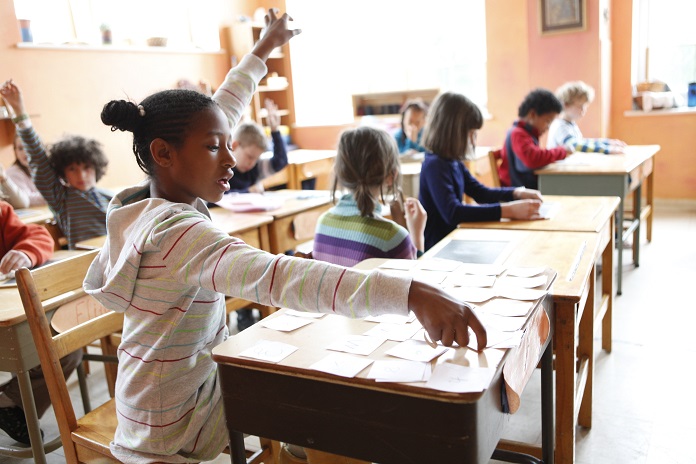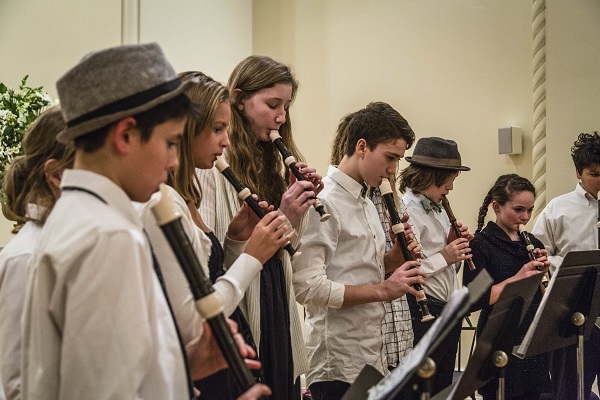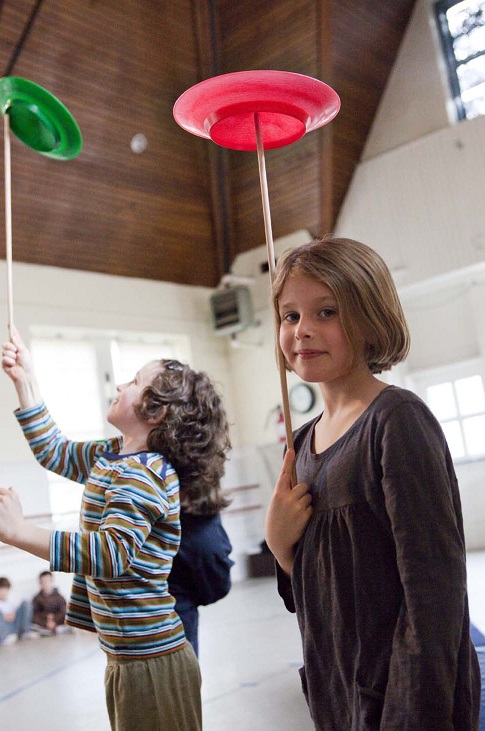Waldorf News
Strength-Based Learning in Waldorf Schools

from phillywaldorf
When your child struggles with math, but excels at violin, do you interrupt the extra long violin practice to drill through a math worksheet?
The question of whether to focus on gifts or work on deficits is not just a question for parents. It is also a daily concern of teachers. The dominant paradigm in education today purports that success requires college, and college requires a measurable set of abilities in key subjects. Students lacking in said subjects must focus on those weakness or else they will not succeed.
Those supporting strength-based teaching tie success to excellence in any of its varied academic, and non-academic, forms. The theory behind strength-based teaching purports that focusing on a deficit simply brings a skill level to average, but never inspires excellence. Excellence is cultivated from strengths. And excellence, and the deep motivation to achieve it, is what students really need to succeed.
The Science
So, is strength-based instruction really the better approach? Scientists don’t yet know as it has not been widely adopted or studied in education. The concept was still just emerging at the turn of the 21st century. But the experts are already calling for its integration into classrooms due to its successful implementation in social services. According to this Lakehead University Study, “The strengths perspective within social work (Glicken, 2004; Saleebey, 1997, 2008) eschews the deficit-based traditions of medical model orientations and has emerged as a credible framework for aiding children and their families in addressing life challenges (Tedeschi & Kilmer, 2005).” Of course, Waldorf educators have been using strength-based teaching for over a century with impressive results.

Waldorf Education and Strength Teaching
Waldorf educators, their classrooms and schools are ideally aligned with the strength-based teaching paradigm. Waldorf schools were created specifically to bring the gifts out in each child through multidisciplinary teaching and a deep personal understanding of the student. Rudolf Steiner believed that every student had within them a potential to change the world in a positive way.
“Waldorf Education is not a pedagogical system but an art – the art of awakening what is actually there within the human being” – Rudolf Steiner
What is already there, in each student, is an intrinsic curiosity and a motivation to learn more about the world around them. Motivation, however, is rarely flourishing within a place of deficit. All people are motivated to learn what most interests them and to excel. If bringing deficits to averages is the educational paradigm within a school, it neglects the student’s primary motivation and fails to engage their hearts’ and minds’ natural curiosities.
Teachers who hope to use strength-based methodology need the support of an overarching school culture (such as Waldorf) that encourages an education fostering excellence, curiosity and lifelong learning. Only with support from administration, staff and parents can teachers feel unrestrained in their classroom approach.
A teacher who feels pressured for each student to reach a particular test score, by subject, will also feel more inclined to focus on deficits.

The How of Strength-Based Teaching
So, what does strength-based teaching look like in a Waldorf classroom? It begins with the simple mission or premise, to see students for gifts they possess, and not gifts they lack. This does not mean ignoring issues with learning, but instead working to connect with a student’s gifts when teaching a less motivating, more deficient skill.
Tapping into Multiple Intelligences – Many think focusing on any one child’s gifts is an unrealistic goal for a classroom of up to 24 children. Surely a teacher cannot focus on this level and get anything done collectively. The answer to this dilemma is not individual child work, but multi-disciplinary teaching. If a teacher approaches a topic using rich and varied experiences, it will stimulate many different styles of learning, or intelligences that the children possess. (Learn more about multiple intelligences as defined by Howard Gardner, American developmental psychologist and professor of Cognition and Education at the Harvard Graduate School of Education). This means there is a greater chance of connecting with and motivating each individual child at some juncture for each topic, and it also gives students an opportunity to perceive themselves as smart in different ways.
Rich, Diverse Curriculum – The teacher also takes care to foster relational properties between topics a child may like or dislike, so that they can have more positive emotions around the subject. The style of teaching in blocks, as done in Waldorf Education, gives children time to become immersed in each academic subject (no ignoring that one class a day). And as the student engages in different interactions with the topic — say, math through music notation, cooking, practice drills, manipulatives and group games — it becomes more likely that they will find genuine curiosity and motivation for overcoming their own deficits.
Classroom Culture – Also key is the cultural paradigm of the classroom, where children are respected and known for their gifts and their deficits. It is true, a child’s peers may recognize when someone is a slower reader, but if that same child is encouraged to help others struggling in math class, then the entire class comes to value each individual’s excellence and uniqueness.
Teacher Mindfulness – The strength-based approach requires teachers to engage in reflective thinking about their values, their teaching, their students and their classroom community and culture. The process of reflection is an ongoing one as they regard their relationship with the students and its impact on each child’s learning and development. In Waldorf education, this is encouraged, as is the long term care for classroom culture, by the one teacher system of education. In Waldorf schools, a teacher will spend multiple years with students, moving with them through the grades to help strengthen the teacher student relationship and provide a steady and supportive classroom environment year upon year.
The Why
We want our children to believe in their own excellence and their own potential for ever greater excellence. The strength-based teaching method is better oriented around this goal. And that ultimately matters because, as the Dalai Lama says, “with the realization of one’s own potential and self confidence in one’s ability, one can build a better world.”

From the Waldorf School of Philadelphia blog, Loving Learning. Check out the post here.
 Jamie York Books, Resources, Workshops
Jamie York Books, Resources, Workshops ~ Ensoul Your World With Color ~
~ Ensoul Your World With Color ~ Summer Programs - Culminating Class Trips
Summer Programs - Culminating Class Trips Bay Area Teacher Training
Bay Area Teacher Training Roadmap to Literacy Books & Courses
Roadmap to Literacy Books & Courses Waldorf-inspired Homeschool Curriculum
Waldorf-inspired Homeschool Curriculum Art of Teaching Summer Courses 2025
Art of Teaching Summer Courses 2025 Middle School Science With Roberto Trostli
Middle School Science With Roberto Trostli Space speaks. Its language is movement.
Space speaks. Its language is movement. Apply Today: New Cohort Starts Nov. 2025
Apply Today: New Cohort Starts Nov. 2025 Discovering the Wisdom of Childhood
Discovering the Wisdom of Childhood Association for a Healing Education
Association for a Healing Education Dancing for All Ages
Dancing for All Ages Waldorf EC Training & Intensives in Canada
Waldorf EC Training & Intensives in Canada Everything a Teacher Needs
Everything a Teacher Needs Immersive Academics and Arts
Immersive Academics and Arts Quality Education in the Heartland
Quality Education in the Heartland Bringing Love to Learning for a Lifetime
Bringing Love to Learning for a Lifetime Storytelling Skills for Teachers
Storytelling Skills for Teachers The Journey is Everything
The Journey is Everything Flexible preparation for your new grade
Flexible preparation for your new grade Transforming Voices Worldwide
Transforming Voices Worldwide Caring for All Stages of Life
Caring for All Stages of Life The Art of Administration and Leadership
The Art of Administration and Leadership Full-Time Teacher Education
Full-Time Teacher Education Grade Level Training in Southern California
Grade Level Training in Southern California Train to Teach in Seattle
Train to Teach in Seattle RSS Feeds
RSS Feeds